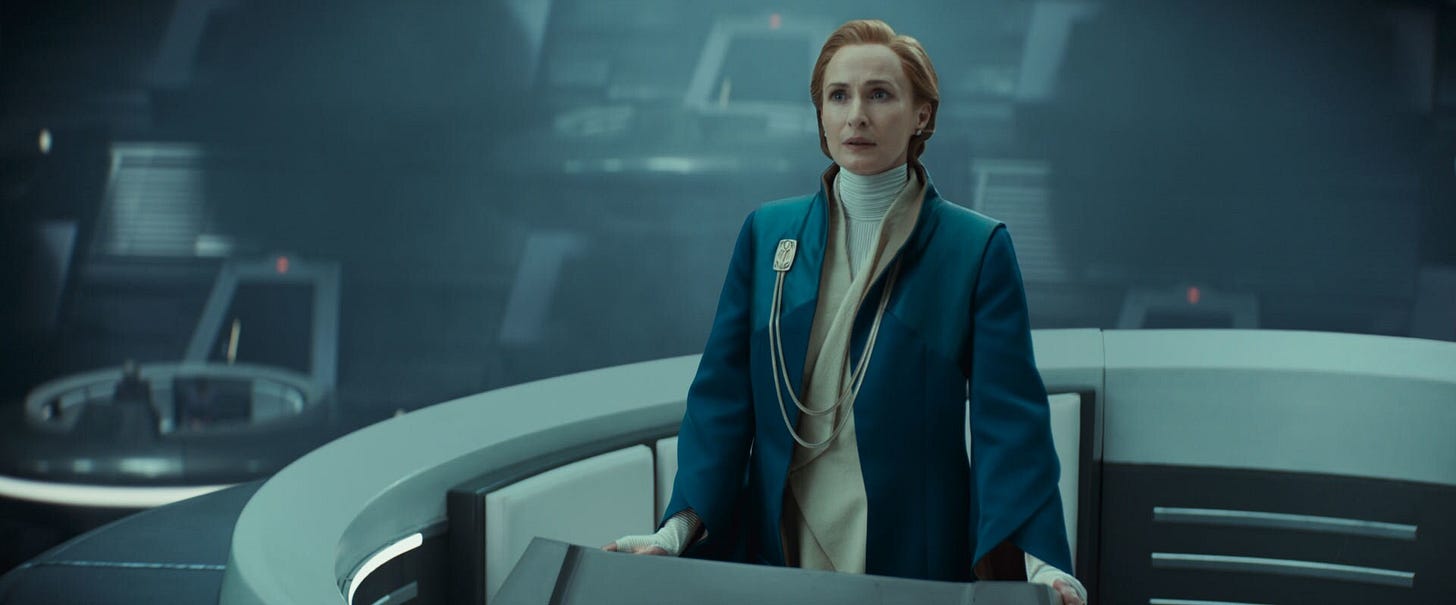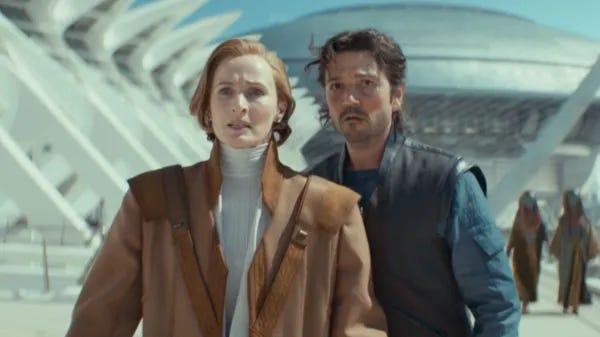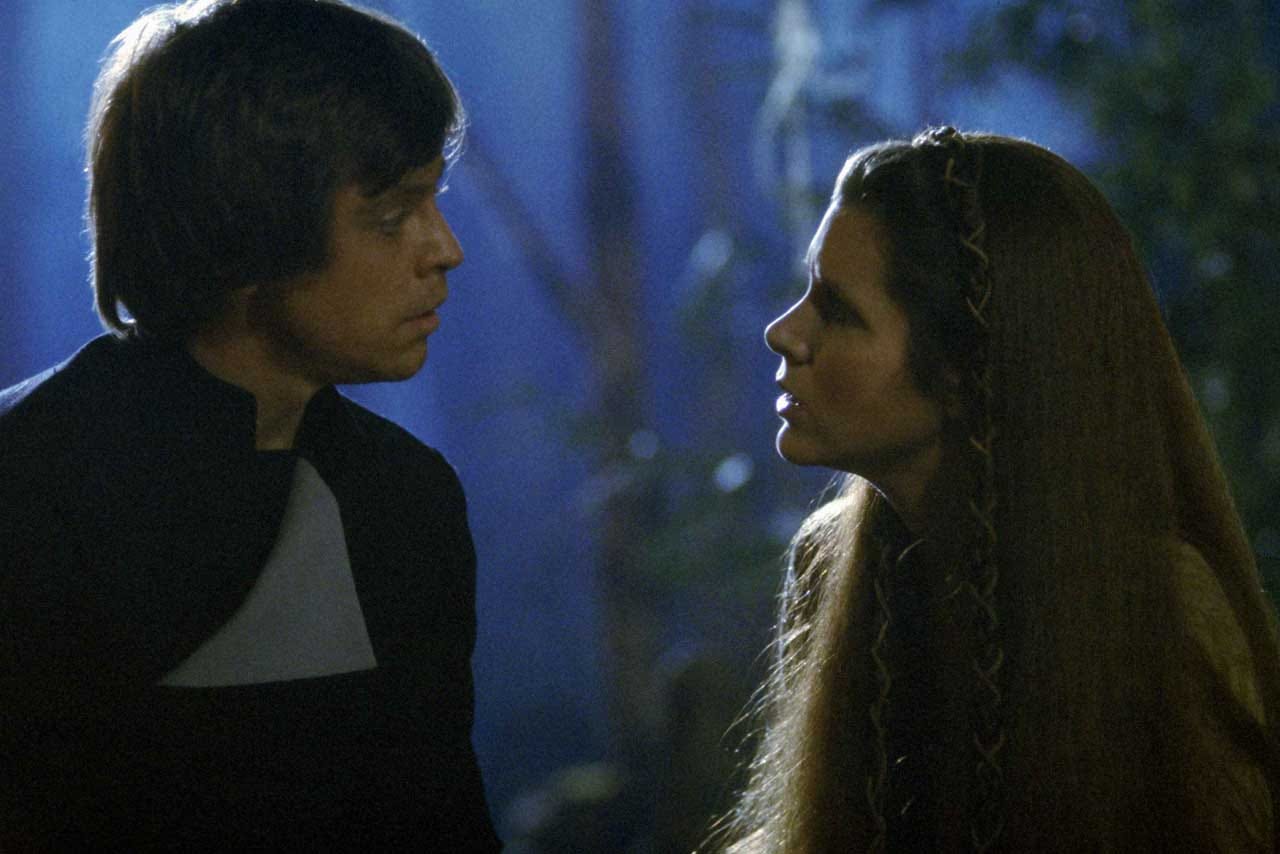Cassian Andor is the messenger and hope is the message in Andor S2 Eps. 7-9.
Despite what some may say, the darker, grittier series punches its Star Wars card.
The Short Take:
Mon Mothma and Cassian Andor steal the show for me here, despite everything in these three episodes being immaculate and riveting. It’s undeniable now that the heart of this series bleeds Star Wars.
[SPOILER ALERT: This review contains details about Andor THROUGH Season 2, Episode 9.]
Image Credit: StarWars.com
The Long Take:
“Welcome to the Rebellion.”
I know a lot of jaw-dropping, gasp-inducing events transpired during these three episodes. Syril reunites with Cassian, attacks him, and then dies after Ghorman front leader Carro Rylanz shoots him. Bix leaves Cassian without telling him. Syril tries to choke Dedra! K-2SO is born?!
But, for me, the most thrilling part of all was watching Cassian Andor and Mon Mothma escape the Galactic Senate on Coruscant. The suspense, of course, was at an all-time high. Where would they go, and how would they get out? Plus the political implications of the sequence bring down the emotional hammer, all the way from Mon’s stirring speech to Bail’s heavy look as he sits in his Senate seat, waiting for the fallout. (Say what you will about recasting, but Benjamin Bratt can act.)
Image Credit: Comic Book Movie
The more distance I had from this arc, the more I realized that this line — “Welcome to the Rebellion” is anything but conventional in how it is presented. We do not hear it once danger has subsided. We do not hear it once Cassian and Mon are in the clear and can congratulate each other. It does not happen with a wink and a nod as Cassian rides off into the sunset after dropping Mon off on Yavin 4. It happens midway through all the chaos, when they do not yet know if they will make it out alive, never mind undetected. That is a deliberately messy, off-beat choice that says a lot the story Tony Gilroy wants to tell.
More specifically, Mon’s initiation into the Rebellion happens after Cassian shoots the Imperial spy right in front of her, officially exposing her to a side of fighting the Empire that she has never actually seen. Recall Luthen’s dagger of a reply to her when she claims ignorance about assassinating Tay Colma, her childhood friend causing problems for the cause: “How nice for you.” A few episodes later, she no longer has that sheltered privilege. When she replies with confusion, saying, “What?” Cassian does not elaborate. He merely continues with their escape plan, no speechifying or anything. Again, this scene is deliberately constructed to convey a sense that when you fight tyranny, when you rebel, you don’t get to choose the conditions under which that happens. Waiting for the right time is a luxury rebels cannot afford.
What prompts Cassian to say “Welcome to the Rebellion” says as much about his character and his role in the Rebellion as it does Gilroy’s messaging about political revolution. The opening scene of this series, after all, shows Cassian talking a new recruit, Niya, through her nerves. He deeply connects with her in a matter of moments and inspires her to go through with it. He frames undermining the Empire as not only an act of survival but an act of self-actualization: “You’re coming home to yourself.”
The scene with Mon eight episodes later echoes that opening scene beautifully. She says, “I’m not sure I can do this,” and only then does Cassian reply with his declaration, as if to say that being a part of the Rebellion naturally comes with doubt, fear, and uncertainty. It’s shaky and unpredictable. Not being sure you can do it means that your heart is in the right place and you’re doing it right.
Image Credit: IndieWire
Many prequels get it wrong. They focus on the wrong goals, as they seem more interested in flaunting their prescience than answering two very basic questions: HOW? and WHY? Greg, P.T., and I just talked about this on our Revenge of the Sith Anniversary Special. We concluded that George Lucas kept his focus on character and myth-making, building the story around how and why Anakin fell to the Dark Side and became Darth Vader. The inconvenient details of how every bit of the plot would align with what happens in the Original Trilogy was always secondary (and sometimes didn’t quite make sense).
Similarly, Andor interrogates the how and why of the Rebellion. How do you go from disparate groups of people or individuals, dissatisfied with tyranny, to an organized, unified, opposing side with its own base planet and army? Instead of going for the Leo pointing at the TV meme version of “Hey, they said Rebellion! Mon Mothma becomes the leader of the Rebellion wink wink” it instead marks a moment of coalescence, when Mothma realizes she’s part of a much bigger and much more organized effort now.
The title of Episode 9 is “Who are you?” and more often than not the answer to that question is… nobody. (Poor Syril got Don Draper-ed.) People who played key roles in Galactic events but would never be named in a history book. So rather than a grand “hey we know who Mon Mothma becomes later in the other movies” gimmick, the moment is more about how individual acts of bravery and commitment carried out by myriad nobodies can form a rebellion — THE Rebellion.
Image Credit: StarWars.com
And, as I mentioned earlier, Cassian Andor, despite remaining nameless in the Galaxy’s history, is a special figure. A messenger, as the Force healer on Yavin 4 calls him. We see that the Rebellion clearly hinges on him in Episode 9 as he is the one — the only one — who can successfully smuggle Mon Mothma out of the Galactic Senate after she has given her mic drop of a speech, speaking out against the Gorman Massacre.
Consider all that is working against Mon Mothma trusting Andor: in Season 1 she realizes her driver is an ISB plant, and in Episode 9 of Season 2 she learns that her trusted assistant, Erskin Semaj, has been working for Luthen ever since her daughter’s wedding. And then, to make matters worse, Luthen warns her that the team of her other reliable friend and confidante, Senator Bail Organa, has been infiltrated by the ISB and can no longer be trusted to get her out safely. So by the time she encounters Cassian, she really has no reason to believe or go along with anyone trying to help her.
And yet, Cassian does it. He uses all his charisma and empathy, his purity and passion, to convince Mon Mothma to take his hand as she begins to give in to fear and self-doubt.
In other words, The Force is strong with him.
The most noteworthy occurrence in this three-episode run might be that a discussion of what makes Cassian special introduces the notion of destiny and the Force (though it is never explicitly named — such restraint, Tony Gilroy!) to a show that some fans accuse of not being “real” Star Wars because there are no Force users with lightsabers running around.
But, if I angle my thinking a little, this subtle and implicit reference to The Force is actually much more in keeping as set-up for the way the galaxy thinks about the Force and the Jedi circa A New Hope. In that first film, imperial officers like Admiral Motti jeer at Vader, accusing him of clinging to an “ancient religion” with misguided devotion. Han Solo famously tells Luke that “hokey religions and ancient weapons are not a good match for a blaster at your side, kid.” This skepticism and cynicism has been baked into Star Wars’ DNA from the beginning.
Image Credit: Wookieepedia
So it makes sense that, long after Order 66, someone like Cassian would be extremely skeptical of The Force. Bix insists that the Force healer on Yavin 4 isn’t a “scam,” which implies that he thinks she is. He seems very resistant to getting anywhere near the Force healer and accuses Bix of setting him up. And yet the interaction that follows cannot be denied, at least to the Force healer, Bix, and the audience: “there’s some place he needs to be.”
Now we all know that place is Scariff in Rogue One, helping Jyn Erso send the Death Star plans to the Rebel Alliance. But, again, I think the less conventional presentation of that prequel-y premonition lies in how gradually we have established Cassian as that messenger of hope. He gave Niya that sense of hope and that, even if she died, it would all be worth it. He gave Mon Mothma that sense of hope when she wavered, issuing her the challenge to make all he had done for her worth it.
And here, yet again, we see him doing that with the Force healer, as she says that she was beginning to doubt in her own Force abilities, saying “I thought it had gone for good” and “It’s so easy to lose faith.” Cassian gives her a sense of clarity of purpose. That is his special (Force? I’m not ready to go that far yet) ability.
Image Credit: Decider
Considering all this, but especially this epiphanic moment of clarity on Yavin 4, I am reminded of another original trilogy film: Return of the Jedi. It is on Endor that Luke gives Leia a sense of clarity by telling her that they are twins separated at birth, the children of Darth Vader. In doing so, he allows them both to find a sense of peace and lucidity through a better understanding of their connection to The Force and each other. And that carries them through the final battle.
I’ve always credited the lush natural forest of Endor as a, albiet minor, factor in that moment of enlightenment for Luke and Leia. Perhaps because I assumed it would amplify their connection to the living Force. Visually, Bix and Cassian’s living quarters on Yavin 4 evoke Endor with the round or hexagonal nature of the huts like the treehouses Ewoks dwell in, and Bix’s more relaxed, hairstyle is reminiscent of Leia’s long, flowing hair when she emerges from the crowd of Ewoks.
I would guess this mirroring is intended to give the impression that Bix and Cassian have found some form of domestic bliss on Yavin. In stark contrast to the cold and claustrophobic apartment they shared on Coruscant, this new home seems to be more in touch with nature and peaceful, like Endor would have been for Han, Luke, and Leia.
Image Credit: StarWars.com
Part of me wonders if, in drawing this parallel, Gilroy actually intends to highlight the fallacy of Endor’s idyllic allure, as just a way to temporarily forget the harsh realities of war. (Am I saying Ewoks are denial enablers? Maybe just until they encounter storm troopers.) Bix in her Ewok villager get-up, after all, comes to represent what will pull Cassian away from the Rebellion and therefore his destiny. Regardless of what it means, I can’t help but think that the parallel mood of Yavin 4 in Andor to Endor in Return of the Jedi is intentional.
Image Credit: Mynock Manor
As we (really just I, since everyone else has seen the episodes by now probably) anticipate the final three episodes of this season and series, I would bet money on Andor hailing as an all-time best in Star Wars, both in its internal episodic storytelling and as a prequel. Andor’s identity as an authentic Star Wars is as undeniable as Cassian’s destiny because, like all Star Wars stories, at its core we find hope.












I really liked like the interaction between Mon and Cassian as they're escaping Coruscant. She's been in the rebellion longer than he has, but it's her first exposure to seeing the violent side of it up close and personal.